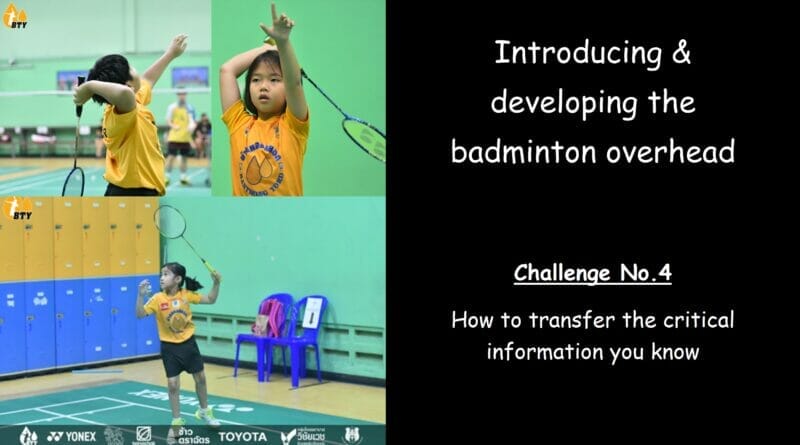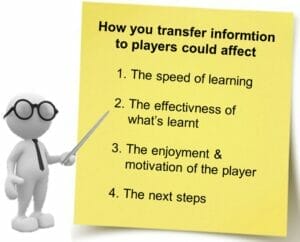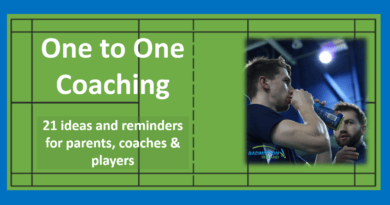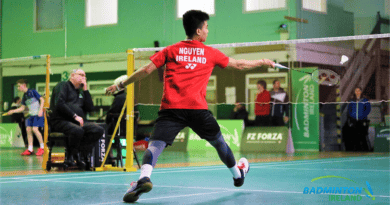Introducing the badminton overhead – Challenge No. 4
The badminton overhead forehand is packed full of critical information
How to transfer the information you know is important
What’s the most effective way to pass this on to beginners?
Is it to transfer all that you know verbally to the players?
That long list of the technical elements you’ve amassed?
Understanding how to choose to communicate is important
This post examines the various ways (the methods) that coaches use to communicate information to players. My aim is for you to consider why verbal (telling/instructing/questions) seems to be the go-to method. Why is this the case, why should you consider if there are other ways.
There are essential aspects that beginner players need to perform when being introduced to badminton overhead striking and somehow they need to be introduced. This is one of the challenges that is examined as part of this mini-series aimed at coaches working with beginner players.
Your challenge is to decide how best to give players information that you know is critical to striking overhead forehands.
You may feel challenged or ‘prickled’ at some of the points raised. My aim is to give you ideas to help make the learning a little easier and to create more smiles than struggles in your coaching sessions 🙂
The methodologies you use to establish the early critical aspects are the key to future development
– – – – – – – – – – – – – – – –
Some background information

If you haven’t read the introductory post I recommend you click here or this image.
It outlines 5 challenges coaches face and why I believe that this movement also attracts the most coaching problems. Maybe even more than an overhead backhand.
You will find a link to each of the 5 separate posts that work through the coach challenge point.
There is also an insight into what happened when I spoke with 2 other coaches about these challenges and how at times, we disagreed! I’ve outlined some of the thoughts we had during our conversation.
I’m not here to change your mind, just to ask you to consider your ‘why’
Please consider the questions, statements and advice
– – – – – – – – – – – – – – – – – –
How to transfer critical information to beginner-level players
Why it’s important to discuss this challenge
Method 1 – using mainly verbal instruction
Method 2 – practice by doing rather than listening
Method 3 – practice by copying and using ‘cues’
Conversation starters for you and your coaching friends
– – – – – – – – – – – – – – – –
Why it’s important to discuss this challenge
Without a coach providing information a performer’s learning will be slower, possibly less effective and may be less enjoyable. I’m sure you could provide an argument against these 3 points, but that’s for another post.
However, how you choose to transfer the information could also have the same 3 impacts!
Coach education often provides more information about what to include in your practice rather than how to communicate it.
The default method for transfer of information (Tutor to Coach) in most courses and subsequently the one used in assessment and then real-life coaching is to verbally communicate all you want the player to do. How effective is this style?
Coaches are expected to talk and give information
– but often it’s the least long-lasting way to establish learning over a period of time
Consider how you package your critical learning points for the badminton overhead when you are coaching, are they all given as verbal requests or key points?
Or, do you ‘hide’ some of them within the tasks and practices you set? – the task (practice) provides the key outcome without the performer initially knowing and being aware. Does this make sense to you?
Discuss with a friend the different ways you could communicate critical information to a player
Is it possible to establish & develop critical information without ‘telling’ ?
– – – – – – – – – – – – – – – –
Using mainly verbal instruction
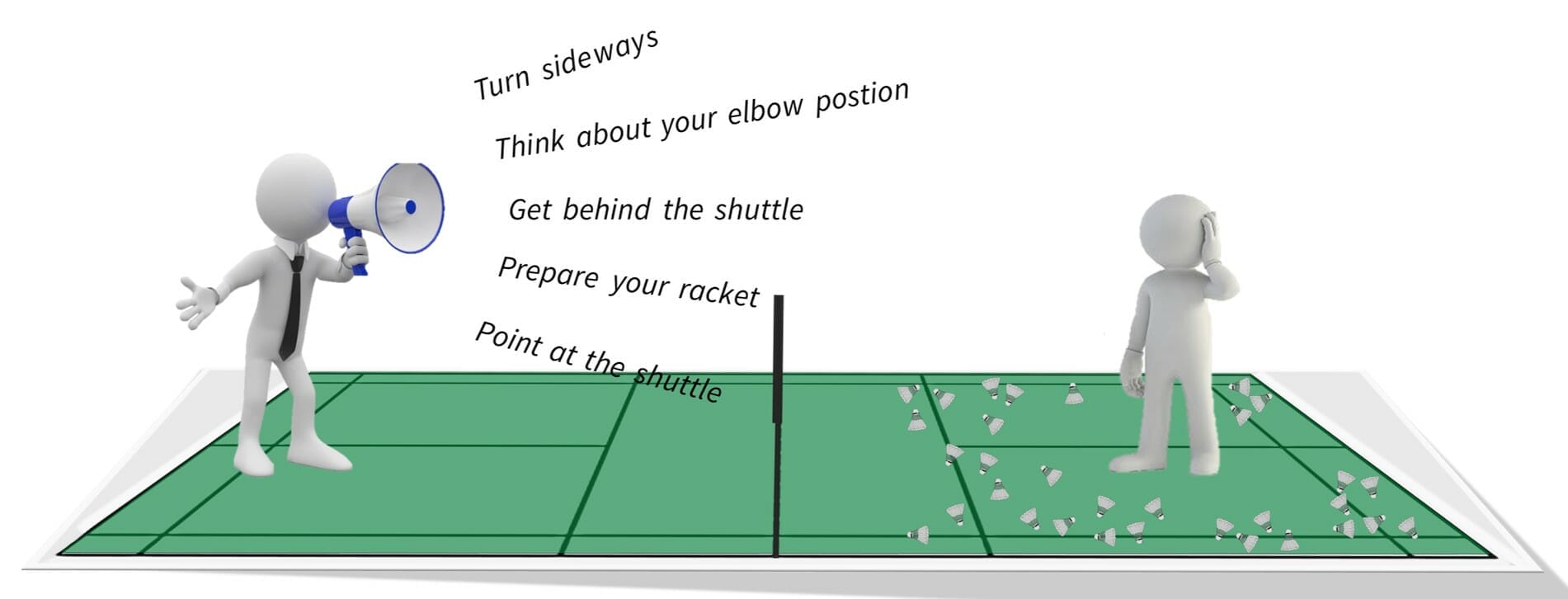
When coaching beginners in any strokes and especially complex ones like the overhead forehand coaches are often motivated to give information. The critical (essential) information that they know.
The issue I see is that most often it’s given verbally and crucially as a one-time list that also includes a similar list of do’s and don’ts. This verbal ‘information’ dump can feel satisfying to the coach, it’s what they believe that they are there for.
We’ve all stood courtside and heard the coach try to instil knowledge into players (even beginners) by explaining precisely how to move your arm/elbow, how to prepare and exactly where the racket should be pointing, etc, etc. Their demonstration is near perfect, the words match all their actions.
However, even if the players say that they understand (the coach believes that seeking answers will help the learning) they soon either forget or more likely cannot turn all the words into actions. It can be especially difficult for beginners to turn the coach’s precise instructions into movements that are perfectly sequenced and controllable.
If you like to tell players a list of important factors how often are they able to put them into action?
or do you just accept that some will forget and some will struggle (challenge no.2)
– – – – – – – – – – – – – – – –
Practice by doing rather than listening
What would this look like and does it make sense to you?
To me, it meant a change of emphasis in the methods I’d been shown on coached education courses and the way that I’d been coached.
The delivery methods vastly reduce the information given verbally. Often to the point that other coaches may not hear all the points, they expect and emphasise in their own coaching. I’ve heard it called ‘lazy coaching’ and that it’s so far from the truth. The fact is, I think it’s harder to coach this way, you have to be mentally agile and be constantly making decisions offer what and what to do.
Of course, you will verbally set out the practice, the task, and maybe the challenge. But crucially the technical ‘list’ will be as short as you can make it. Plus the information won’t sound like a manual – well not the current manuals! 🙂
The challenge of this practice type is to provide the player with a great learning experience but through the execution (doing) of the practice/task but without extensive complex technical verbal instructions.
Observing from off court it may look like the players are performing simple tasks with limited coach instructions
Can you deliver a practice in such a way as to
- ensure that players get into action, sometimes before you’ve finished talking – that’s ok 🙂
- everyone understands the basic elements: the challenge, how to start, the general intention, what ‘completion’ looks like
- players then start performing something near to the coach’s desired goal – not perfect practice but it looks similar
- players are motivated to try, make mistakes (errors) and achieve a success rate that increases quickly from 40 – 70%
- use constraints (the above information) to provide a ‘funnelled’ learning experience that tries to establish a development
- at the end of the practice, it’s clear to the coach and player (maybe) what the next step/development could be
Does it fit these criteria
- build on previous work : there are ‘anchors’ of technique, challenge, motivation, and desires that can easily be built upon
- all challenges/requests are 50-70% achievable
- contain specific technical coach wanted critical aspects – but delivered through practice constraints, challenges, etc
- constraints that work to avoid those future development-limiting issues
- allow future easy development steps
The challenge for coaches is deciding how to set (constrain) for each practice
with aim of developing a skill (or part skill) through a task – not excessive verbal instruction
– – – – – – – – – – – – – – – –
Practice by copying and using ‘cues’ in different ways
This method falls between the two above. There will be verbal instructions or guidance, however, the difference is that they will draw attention to various aspects rather than a list of technical requirements. Plus as well as the practice/challenge providing a condition/constraint, the player will be given a cue or observation to follow.
The cues and visual aspects can easily be acquired by the coach (if they collaborate with others), however, the greatest challenge will always be why and when to use them. Read more in Challenge No.3
Do you agree with these Do’s & Don’ts below
What thoughts and questions do they create?
Do’s
- Show images of starting and end positions – ask players to replicate them
- Create thoughts about the movement – “pulling your elbow back & down in preparation”, “getting up off the ground prior to starting your throw”
- Create practice situations that enhance technical elements – but don’t tell the player what you are doing. Let the practice provide the development, or change the practice
- Start in the Backhand court – feeding over the non-racket shoulder
- Use shadow movements with a full powerful throw as part of the warm-up, or just before on-court striking attempts
Don’t’s
- Ask the players to concentrate on body part movements that happen in the middle of a power throw
- Use slow-motion throwing in practice, and certainly not with stop-start movements
– – – – – – – – – – – – – – – –
Conversation starters for you and your coaching friends
Why not find a few other coaching friends and start a conversation explore these questions and statements below. Hope fully you will find them stimulating and a little bit ‘prickly’, that is my aim! Coaching the badminton overhead is a fascinating, complex process 🙂
– Telling is faster or is it?
– Coach Education experiences don’t help
– Will pre-loading information will avoid errors
Telling is faster or is it?
Surely the best way is to just ‘Tell” players the information they need? Telling them is a faster process so they can then start to practice all that they’ve heard.
You are experienced, you know what’s required, and you know it works, so just tell them. Isn’t that what good coaches do, pass on information that works?
The information you know is important there is no doubt about that, but just telling someone really doesn’t work. Well, it may work for a very short while if you are fortunate but very soon it can seem to disappear. So what do we do next, we repeat and try again.
Beginner players don’t seem to remember what they are ‘told’
This can apply to all levels of performers, but with novice players (beginners) it’s even more so
Coach Education experiences don’t help
Most badminton Coach Education (at the time of writing this) is delivered from a Turor-centred approach. The tutor delivers information generally in a verbal one-way style.
They explain what you need to know and the reasons why. During assessments, you are expected to instruct players and to verbalise specific information in order that they can ‘improve’. In fact, it’s more about the assessor wanting to confirm that you have the knowledge and understanding of key information. The assessment format often requires the Assessor to ‘tick off’ the competencies that include ‘technical key points ‘.
However, rarely on Coach Education courses are you given a ‘warning’ to be careful about how you deliver the information you’ve just heard. The importance of how you transmit information (in various ways) is equal to what you include in your communication.
Coaches often replicate how they were taught in their coach education courses
However, creating player learning environments is very different
Will pre-loading information will avoid errors
In life, people will receive lots of critical information verbally. We can all give plenty of examples of being advised or told what to do. I’ve met people who feel comfortable being told what to do and suggest that it’s the best way for them to learn. “Just tell me then I know what to do”.
This is commonly seen (or heard) when coaches pre-load players with information before they initially attempt something. The reasoning is that with this ‘critical’ information there is less opportunity for an error or mistake occurring. However, often the errors still occur during the initial attempts!
Do you believe that imparting critical information (especially technical information) verbally at the start of practice/task will increase the possibility of success?
I do, but will it also increase the success of long-term learning, I’m not sure about that.
Complex skills require practice and tryouts. Ok, the mistakes still happen but the situation that they are made in is hopefully managed or constrained. We are still given pre-information, but crucially it’s just enough to attempt the task.
Consider how much you rely on verbal transfer, especially technical information
If it’s with the aim of error avoidance, how often is it successful?
– – – – – – – – – – – – – – – –
I hope to prickle your thoughts and beliefs 🙂
My desire is that you will consider the discussion points and challenges, I hope you have time to do that. The ideas and suggestions listed here are my best advice at this time. It’s up to you to decide what to take, use, and maybe reject.
Please do not assume that every statement or bullet point listed regarding coaching the badminton overhead is essential or has an equal weighting. Some are ‘could haves’ and others are essential ‘must haves’
Often the timing of the coach action is more important than what is done by the player
This is the ‘hidden’ coaching skill.

